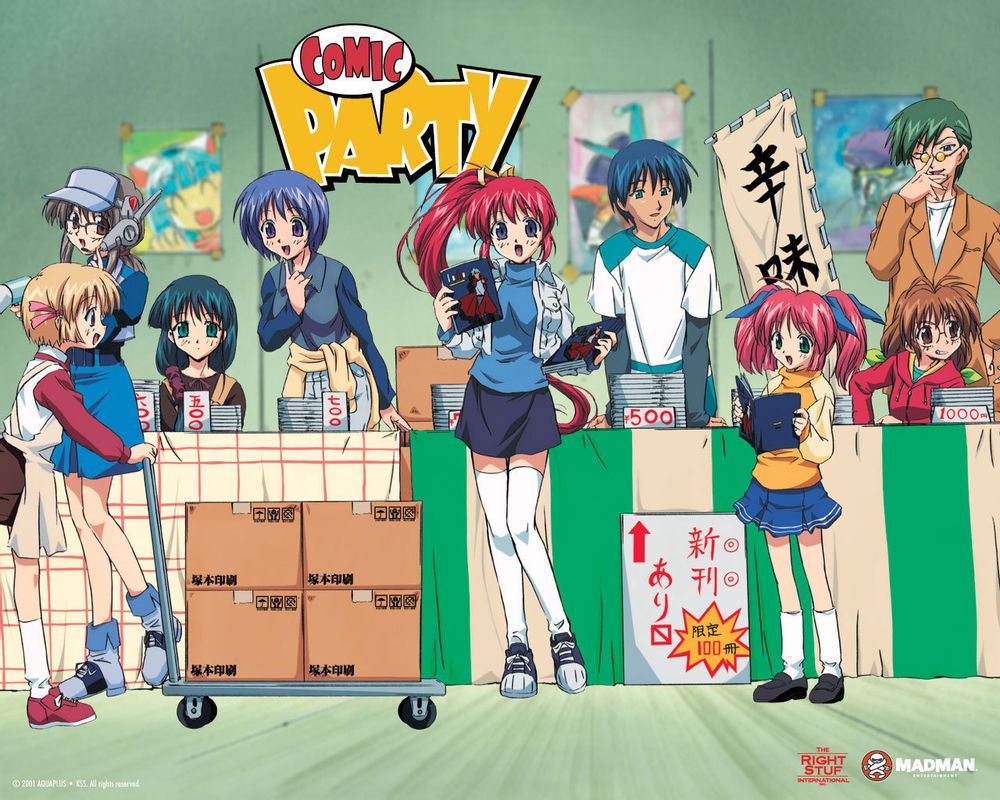
In Comic Party, Kazuki Sendō goes to a convention center in Tokyo with his friend, Taishi Kuhonbutsu. As it turns out there is a convention named Comic Party being there held that day. Kazuki meets several dōjinshi artists and enjoys his time. Since Kazuki can draw decently himself, Taishi encourages him to make his own doujin. Despite another friend of his, Mizuki Takase, discouraging him on the basis of Otaku being gross and smelly he decides to give it a try.
Comic Party began as a romantic adventure and dating sim video game by Leaf. The original PC release contained adult content but subsequent re-releases on the Sega Dreamcast, PC, and PSP were cleaned. This game was inspired from the real world event of Comiket held in Tokyo bi-annually. Comiket is a Doujinshi fair where artists gather to share their work.
Comic Party has since become both a manga and a two-season anime series, as well as generating merchandise like figures and artbooks. The manga was penned by Sekihiko Inui, who would later create Murder Princess, and was released in the US by the now-defunct Tokyopop. The first season was released in the US by RightStuf (Discotek Media later picked it up for the re-release). The second season, Comic Party Revolution, was originally released in the US by ADV Films, until it landed in Funimation's hands due to the Sojitz mess-up.
Mizuki also appears as a playable character in The Queen of Heart, a series of doujin Fighting Games by Watanabe Seisakujo (Now French Bread), more specifically in the second game, QoH '99; and the characters from Comic Party appear prominently in the third game, Party's Breaker: The Queen of Heart 2001.
Much later, Mizuki and Yu were chosen as support characters in Aquapazza, a Fighting Game developed jointly by Aquaplus and Examu.
Comic Party provides examples of:
- Bowdlerise: The original PC release contained adult content, but all later releases toned down the content significantly.
- Casting Gag: Applies to Revolution's dub specifically. Larissa Wolcott once again voices a character originally voiced by Jessica Calvello. note
- Cosplay Otaku Girl: Reiko Haga is a cosplay enthusiast and promoter. In the manga, she even teaches Mizuki about the nuances of cosplay.
- Cultural Translation: In the English dub of the first season, yen becomes dollars, and kimonos become Prada dresses. Oddly, the yen is shown and it is still called dollars.
- Fictional Counterpart: Comic Party/Comipa is fictional a version of the Comic Market/Comiket convention in Tokyo.
- Fiery Redhead: Mizuki has red hair and has a very exhuberant personality.
- Funbag Airbag: In the fourth episode of the anime series the male lead takes several seconds, during which the female even cheerfully asks if he's alright, before he finally realizes he has run straight into her breasts.
- Hot-Blooded:
- Taishi. Did you know manga is Serious Business? If not, then you don't know Taishi, a grandiose drama king who treats everything as a matter of life or death.
- Yuu Inagawa, who gives a rousing speech about "Burning Passion" and "Passionate Love", which culminates in a vast inferno starting up behind her. She was trying to motivate a friend to... be more passionate about doujinshi.
- And Subaru, who honestly seems to think her life is a shounen manga (and that she's the star). Being a tokusatsu fan also helps.
- Large Ham: Taishi. In the English dub, both Liam O'Brien and Jessie James Grelle really showed off their hamminess when voicing Taishi.
- Most Writers Are Writers: Though it started as a game, eventually Comic Party became a manga about making doujin written and drawn by a doujin artist.
- Mystical 108: In the Halloween special episode of Comic Party Revolution, the characters explore a near-abandoned old school building. One of the characters breaks out a book listing 108 ways to deal with scary situations.
- Paper Fan of Doom: Yuu Inagawa is a also a fan-wielder as well as speaking in Kansai accent (Kansai being a region where fan-based slapstick routines are very common).
- Shout-Out:
- The first episode references Akari Kamigishi, Hiroyuki, and HMX-12 Multi from To Heart. Later episodes reference HMX-12 Multi via dōjinshi fan art and cosplay outfits.
- When Kazuki and Mizuki meet Taishi at ComicPa, he references Space Battleship Yamato by shouting a call to go to Iscandar.
- Kazuki compares the loud convention to a Rancid concert.
- Kazuki also compares it to a Slipknot concert shortly afterwards.
- Taishi's sunglasses are nearly identical to Vash the Stampede in the visual novel, but the first anime gets rid of the zigzag temples and Revolution made the lenses red.
- When Yū Inagawa is first introduced, she looks like Naru Narusegawa in her highschool disguise with huge glasses and a hoodie.
- Revolution pretty much only limits the direct shout outs to other series owned by Leaf/Aquaplus and anything outside of that is relegated to a Lawyer-Friendly Cameo. ADV tries to mitigate this in their dub ofthis season, but it ended up resulting in examples like mistaking the Cardcaptor Sakura analogue Card Master Peach as Wedding Peach of all things.
- Those Two Guys: The two unnamed otaku, credited as Horizontal Guy and Vertical Guy. They basically act as walking examples of terrible convention etiquette and everything bad about the otaku community. They're rude, opinionated snobs who have no qualms with telling artists that they suck to their face, taking pictures of cosplay girls without permission, and just generally disregarding any rules or common courtesies that they don't feel like following.
- Verbal Tic: Subaru often says "ugyuu" for no reason at all. It's, among other things, her equivalent of "Oh?"
